Strensall Common SSSI (Strensall Training Area)
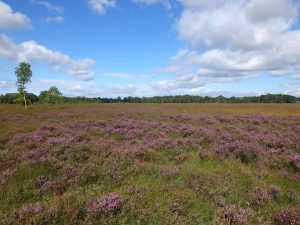
Strensall Common is an area of heathland between Strensall and Flaxton to the north of York and covers an area about 660 hectares. It is owned by the MOD and is used for troop training and the southern part has live shooting ranges with a protective ‘safety zone’ behind. When not in use the whole area is accessible apart from the ranges themselves, otherwise only the northern part and certain other areas can be visited, as explained below.
Habitat
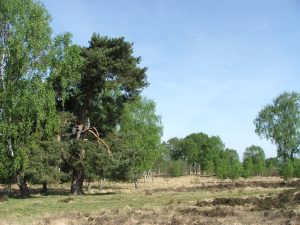
Strensall Common is one of the rare areas of lowland heath in the York area, primarily on acidic sandy soils and has a range of habitats such as wet and dry grassland, scattered birch, gorse and pine, heather and scattered ponds and marshy areas. The southern part is more open with mown and rough grassland which is used for the firing ranges, but with some areas of open birch and pine woodland. This diversity has meant it has been recognised as an SSSI for its populations of nationally important insects and plants.
Bird Life
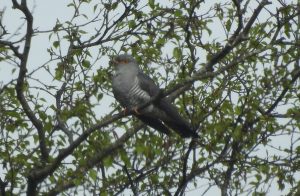
There is a wide range of birdlife with a number of ‘red and amber-listed’ farmland and heathland birds and lowland breeding waders such as Curlew. In the spring and early summer the common reverberates with the sound of Skylark, Yellowhammer, Linnet, Reed Bunting, Tree Pipit, Willow Warbler, Chiffchaff, the occasional Curlew and ‘yaffling’ Green Woodpecker. Cuckoos are still frequent with around five males calling each year, and a few pairs of Stonechat are resident. Woodlark were first recorded breeding in 2005, increased to seven territories in 2006 and are now stable at around three – five territories annually. Listen for their ‘fluty’ song high in the sky on sunny days from March to May. Nightjars were first recorded in 2016 and numbers of territories have increased to four or five each year. Woodcock are occasionally encountered. Tawny Owls are regular and in some years Barn Owls and Long-eared Owls have been recorded. Little Grebe occur regularly on the “butt ponds” behind the ranges along with Grey-lag Geese, Sedge and Reed Warblers and Reed Buntings.
Passing migrants also use Strensall Common with Whinchat, Wheatear and Common Redstart occasionally recorded on passage.
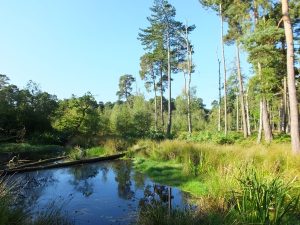
The winter period is fairly quiet, with a few Meadow Pipits, Reed Bunting, Stonechat and Green Woodpecker, although there have been occasional sightings of Hen Harrier, Lesser Redpoll and Short-eared Owls, mainly over the northern part. There is a large corvid roost in the central area during this period.
A survey of breeding birds is carried out annually and the results are reported to the MOD Conservation Group.
Other Wildlife
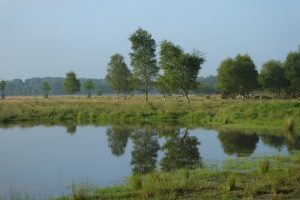
There are a number of interesting plants and animals to find, for example Sundew, Lousewort, Petty Whin, Marsh Gentian and Spotted Orchids are found in some spots and the flowering heather is impressive in August. Watch out for Common Lizards, Adders basking in the dead bracken or heather and dragonflies which are abundant around some of the ponds, with glow-worms sometimes showing at night in June and July. The common is also the last site in England for the Dark Bordered Beauty moth which feeds on dwarf willow. Foxes, Badgers and Roe deer are sometimes seen and Water Voles have recently been found.
Access
The main parking places are on the road out of Strensall towards Flaxton. The first is at Scott Moncrieff Road, opposite Moor Lane, Strensall, Grid ref SE 636 598 and gives access to the ‘southern part’, when the shooting ranges are not in use.
The other (known as Galtres), is one mile further on past the golf course on the right, immediately after the first cattle grid, opposite ‘Moorside’ Caravan Park at SE 648 612 and gives access to the northern part, which is normally open at all times.
Display boards for visitors, with maps and notices of firing times, are present at both locations and there are open areas accessible from both car parks, with a sign-posted ‘nature trail’ between the two. For longer, ‘circular’ walks the northern area has paths leading east (on a little metalled track) and south-east (track and paths) from Galtres car park.
The central/southern area is fenced and is closed normally from 7.30am to about 4.30pm most days, occasionally later for night firing practice. This fenced area has four access gates and these are always locked when access is unavailable, so you cannot physically ‘wander’ into the danger area. Friday is normally a maintenance day with no firing, so the whole area is accessible apart from the shooting ranges, and the gates are open. Access to the shooting ranges is only possible by arrangement e.g. for survey or research work or group visits.
The southern part of the common is easily accessible by number 5 or 5A bus from York. Get off at the Garage opposite the camp and walk north-east along Ox Carr Lane, with the Six Bells Pub on your left and the camp housing on the right, until after about 500 metres you turn right at a blue and white sign up Scott Moncrieff Road (opposite Moor Lane).
Nigel Boatman
19 November 2023
The author is always willing to advise on access or other questions about the Common and hear of bird records to supplement the annual MOD survey.
